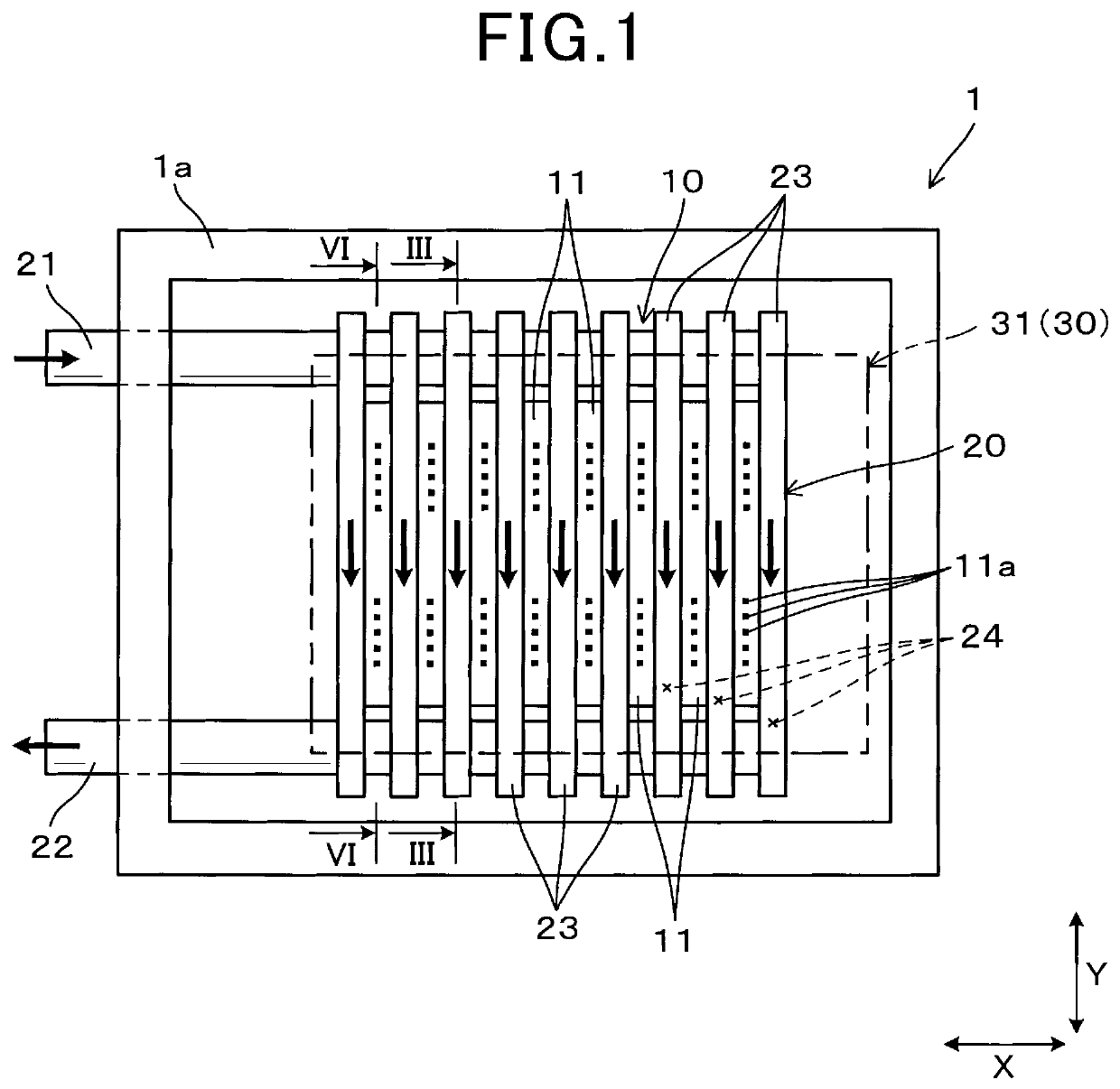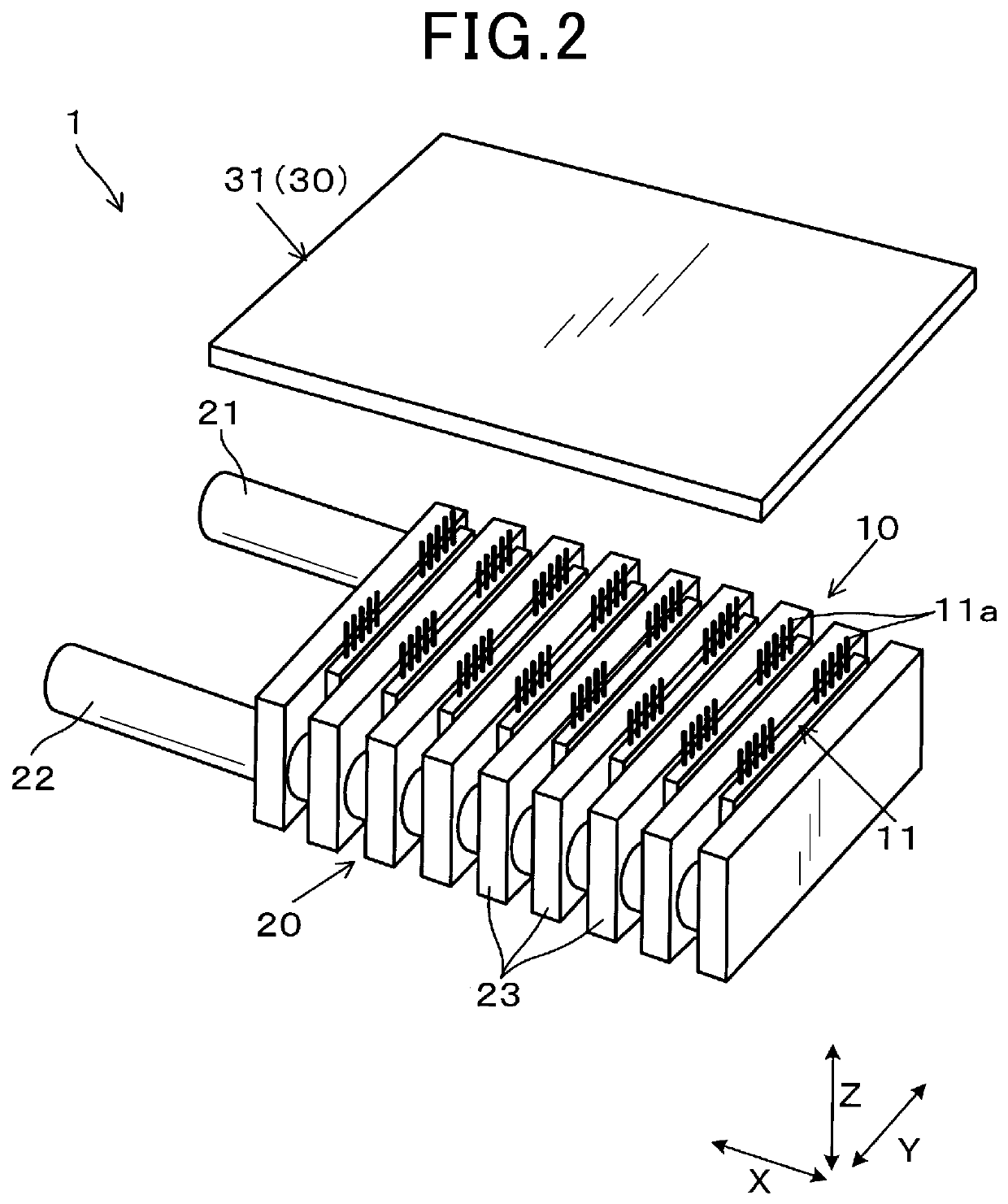Semiconductor device having switching element suppressing potential variation
a technology of switching element and potential variation, which is applied in the direction of electronic switching, electrical apparatus construction details, pulse techniques, etc., can solve the problems of unstable gate potential high potential difference of the emitter, and malfunction of the switching element,
- Summary
- Abstract
- Description
- Claims
- Application Information
AI Technical Summary
Benefits of technology
Problems solved by technology
Method used
Image
Examples
first embodiment
[0054]As shown in FIGS. 1 and 2, the power conversion device 1 comprises a plurality of elements including a semiconductor lamination unit 10 and a control circuit board 31 of a control part 30. These plurality of elements are housed in a space partitioned by a case 1a. The case 1a is an automobile component that is lightweight and requires high dimensional accuracy and is made by aluminum die casting method using aluminum.
[0055]The semiconductor lamination unit 10 comprises a plurality of the semiconductor devices 11 of the first embodiment, and a cooler 20 for cooling these plurality of the semiconductor devices 11. FIGS. 1 and 2 show eight semiconductor devices 11.
[0056]The cooler 20 comprises an inflow pipe 21 extending in the first direction X, an outflow pipe 22 extending in the first direction X, a plurality of cooling pipes 23 extending in the second direction Y and arranged at a predetermined interval with regards to the first direction X. FIGS. 1 and 2 show nine cooling pi...
second embodiment
[0095]As shown in FIG. 11, the semiconductor device 11 of the second embodiment is different from the semiconductor device 11 of the first embodiment regarding the arrangement of the emitter terminal 11n.
[0096]In the second embodiment, the emitter terminal 11n of the semiconductor device 11 extends to one side of the heat sink 17, i.e., from the right side to the second direction Yin FIG. 11.
[0097]The semiconductor device 11 is constituted so that the distance from the emitter terminal 11n to the recirculation element 15A becomes no greater than the distance from the emitter terminal 11n to the switching elements 14A.
Further, the semiconductor device 11 is constituted so that the distance from the emitter terminal 11n to the recirculation element 15B becomes no greater than the distance from the emitter terminal 11n to the switching element 14B.
[0098]The other configurations are the same as the first embodiment.
[0099]According to the second embodiment, even when the arrangement of ...
third embodiment
[0101]As shown in FIG. 12, the semiconductor device 11 of the third embodiment is different from the semiconductor device 11 of the first embodiment regarding the arrangement of both the collector terminal 11p and the emitter terminal 11n.
[0102]In the third embodiment, the collector terminal 11p of the semiconductor device 11 extends to one side of the heat sink 16, i.e., from the upper side in the third direction Z in FIG. 12. Further, the emitter terminal 11n extends to one side of the heat sink 17, i.e., from the right side to the second direction Y in FIG. 12.
[0103]The semiconductor device 11 is constituted so that the distance from the emitter terminal 11n to the recirculation element 15A becomes no greater than the distance from the emitter terminal 11n to the switching elements 14A.
[0104]Further, the semiconductor device 11 is constituted so that the distance from the emitter terminal 11n to the recirculation element 15B becomes no greater than the distance from the emitter ...
PUM
| Property | Measurement | Unit |
|---|---|---|
| distance | aaaaa | aaaaa |
| inductance | aaaaa | aaaaa |
| gate potential | aaaaa | aaaaa |
Abstract
Description
Claims
Application Information
 Login to View More
Login to View More - R&D
- Intellectual Property
- Life Sciences
- Materials
- Tech Scout
- Unparalleled Data Quality
- Higher Quality Content
- 60% Fewer Hallucinations
Browse by: Latest US Patents, China's latest patents, Technical Efficacy Thesaurus, Application Domain, Technology Topic, Popular Technical Reports.
© 2025 PatSnap. All rights reserved.Legal|Privacy policy|Modern Slavery Act Transparency Statement|Sitemap|About US| Contact US: help@patsnap.com



